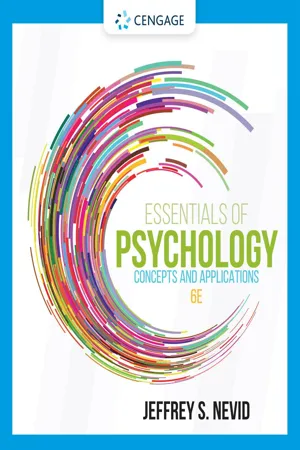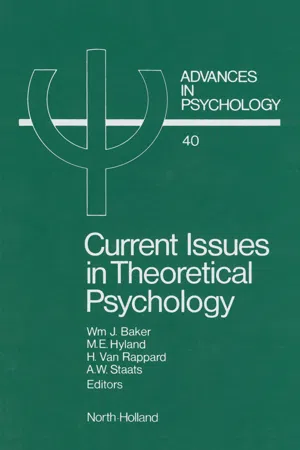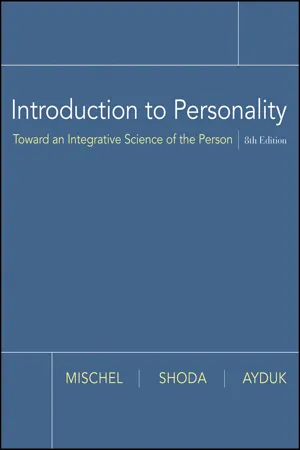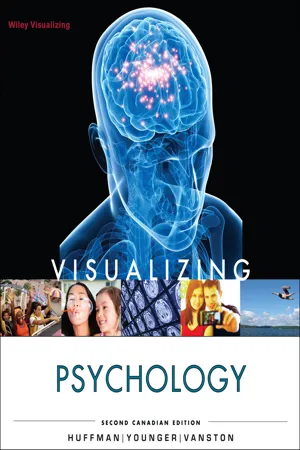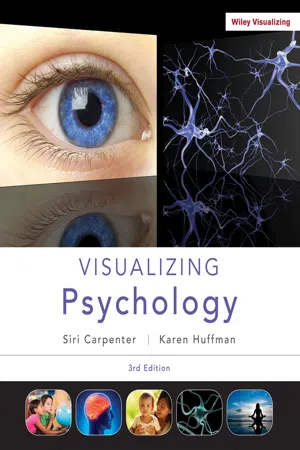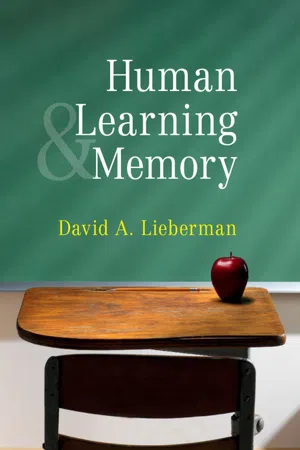Psychology
Conditioning
Conditioning refers to the process of learning and behavior modification through the association of stimuli with specific responses. In classical conditioning, a neutral stimulus becomes associated with a meaningful stimulus, leading to a learned response. Operant conditioning involves learning through reinforcement or punishment of behaviors. These processes are fundamental to understanding human and animal behavior.
Written by Perlego with AI-assistance
Related key terms
1 of 5
11 Key excerpts on "Conditioning"
- eBook - PDF
What is Psychology?
Foundations, Applications, and Integration
- Ellen Pastorino, Susann Doyle-Portillo, Ellen Pastorino(Authors)
- 2021(Publication Date)
- Cengage Learning EMEA(Publisher)
conditioned stimulus (CS) a stimulus that elicits a conditioned response in an organism conditioned response (CR) the response that is elicited by a conditioned stimulus Copyright 2022 Cengage Learning. All Rights Reserved. May not be copied, scanned, or duplicated, in whole or in part. Due to electronic rights, some third party content may be suppressed from the eBook and/or eChapter(s). Editorial review has deemed that any suppressed content does not materially affect the overall learning experience. Cengage Learning reserves the right to remove additional content at any time if subsequent rights restrictions require it. Classical Conditioning: Learning Through the Association of Stimuli 241 Summing up classical Conditioning in a nice, neat definition is a bit awkward but nonetheless extremely important. Once, when one of your authors asked a student to define classical Conditioning, she replied, “What Pavlov did with his dogs.” This isn’t, of course, a definition of classical Conditioning. It does reflect the student’s difficulty in trying to understand the concept of classical Conditioning apart from Pavlov’s particular demonstration of it, however. Keep in mind that to truly understand a concept, you must be able to define it in abstract terms as well as give an example of it. So here goes. We would define classical Conditioning as learning that occurs when a neutral stimulus is paired with an unconditioned stimulus that reliably causes an unconditioned response; and because of this as- sociation, the neutral stimulus loses its neutrality and takes on the same power as the unconditioned stimulus to cause the response. This definition may seem a bit complex, but classical Conditioning is actually a fairly simple process. It merely involves learning to associate two stimuli, the unconditioned stimulus and the neutral stimulus. Through this association, the neutral stimulus becomes a condi- tioned stimulus (You Review: Classical Conditioning). - eBook - PDF
- Matthew H. Olson, Julio J. Ramirez(Authors)
- 2020(Publication Date)
- Routledge(Publisher)
Such a definition still stresses the importance of experience but leaves it to the theorist to specify the kind of experience the theorist feels is necessary for learning to take place. These might include, for example, reinforced practice, contiguity between a stimulus and a response, or the acquisition of information. It also reminds us that experience results in processes other than learning, fatigue for example, that modify behavior. ARE THERE DIFFERENT KINDS OF LEARNING? Learning , as we have seen, is a general term that is used to describe changes in behavior potentiality resulting from experience. Conditioning , however, is a more specific term used to describe actual procedures that modify behavior. Because there are two kinds of Conditioning, instrumental and classical , many theorists conclude that there are at least two kinds of learning or that learning ultimately can be understood in terms of classical and instrumental Conditioning. Although both Conditioning procedures are discussed in detail later on in this book, we summarize both procedures here briefly. CLASSICAL Conditioning We look at classical Conditioning in detail when we discuss Pavlov’s views on learning in Chapter 7, but for now we can summarize classical Conditioning as follows: 1. A stimulus, such as food, is presented to an organism and will cause a natural and automatic reaction, such as salivating. The stimulus causing this natural reaction is called the unconditioned stimulus (US). In this case, the food is the US. The natural, automatic reaction to the US is called the unconditioned response (UR). In this case, salivation is the UR. Gregory A. Kimble. Source : Duke University Archives. 9 WHAT IS LEARNING? 2. A neutral stimulus (one that does not cause a UR), such as a tone or light, is presented to the organism just prior to the presentation of the US. This neutral stimulus is called the conditioned stimulus (CS). - eBook - PDF
Essentials of Psychology
Concepts and Applications
- Jeffrey Nevid(Author)
- 2021(Publication Date)
- Cengage Learning EMEA(Publisher)
But change need not be permanent. It is possible to unlearn behav- ior. For example, you would need to unlearn the behavior of driving on the right side of the road if you wanted to drive in a country where people drive on the left side of the road. Learning is adaptive—it enables organisms to adapt their behavior to the demands they face in the environment. Through learning, organisms acquire behaviors that increase their chances of survival. Even taste aver- sions can be adaptive. They prevent animals, including humans, from eating foods that have sickened or poisoned them in the past. But not all learned responses are adaptive. My own aversion to eggs limits the range of foods I might enjoy. By and large, however, learning helps prepare organisms to meet the demands that their environments impose on them. Psychologists study many forms of learning, including three major types that are the focus of this chapter: classical Conditioning, operant Conditioning, and cognitive learning. 5 Copyright 2022 Cengage Learning. All Rights Reserved. May not be copied, scanned, or duplicated, in whole or in part. Due to electronic rights, some third party content may be suppressed from the eBook and/or eChapter(s). Editorial review has deemed that any suppressed content does not materially affect the overall learning experience. Cengage Learning reserves the right to remove additional content at any time if subsequent rights restrictions require it. 182 CHAPTER 5 LEARNING MODULE 1 Define learning in psychological terms. 2 Explain how conditioned responses are acquired and describe the contributions of Ivan Pavlov. 3 Explain the process by which conditioned responses become weaker or disappear. 4 Explain how conditioned responses can be strengthened. 5 Define stimulus generalization and discrimination and describe their roles in classical Conditioning. 6 Explain classical Conditioning from a cognitive perspective. 7 Apply classical Conditioning to examples discussed in the text. - Sarah Rundle(Author)
- 2013(Publication Date)
- Academic Press(Publisher)
CHAPTER 4: LEARNING AND Conditioning. 1. The study of learning processes is a. largely independent of other fields of psychology. *b. an important element in many fields of psychology, (p. 127) c. related to developmental psychology and to perception but not to fields like personality and abnormal psychology. d. of theoretical interest but has little relationship to the every day affairs of humans. A DEFINITION OF LEARNING 2. According to Kimble's definition of learning, if you know how to tie your shoes it is because a. someone showed you how. b. your coordination improved until you were able to do it. *c. you were rewarded for shoe tying, (p. 127) d. you figured out how to do it by watching someone. 3. Learning is defined as a change in a. the physiology of the brain. *b. behavior potentiality, (p. 127) c. what one knows or knows how to do. d. the amount of information stored and the manner in which the information is organized. 4. The most controversial aspect of Kimble's definition of learning is the specification that a. learning will not occur without practice. b. learning refers to the potential for behavior rather than to behavior that actually occurs. c. learning represents some type of change. *d. practice must be reinforced, (p. 127) 5. Kimble's definition of learning refers to changes in behavior potentiality. This means that *a. behavior is not always an accurate indicator of whether learning has occurred, (p. 127) b. learning cannot be inferred from the observation of behavior. c. learning cannot be directly reinforced. d. all of the potential for learning cannot be tapped. 6. Kimble's definition of learning specifies that learning takes place as a result of a. maturation. b. fluctuations in motivational states. *c. reinforced practice, (p. 127) d. All of the above result in learning, according to Kimble. 51 52 CHAPTER 4 CLASSICAL Conditioning Pavlov's Experiments 7. Pavlov's experiment involved a dog learning to a. eat meat powder.- eBook - PDF
- Nancy Ogden, Michael Boyes, Evelyn Field, Ronald Comer, Elizabeth Gould(Authors)
- 2021(Publication Date)
- Wiley(Publisher)
Operant Conditioning 275 Operant Conditioning LEARNING OBJECTIVE 3 Describe the basic processes of operant Conditioning and explain how shaping can be used to teach new behaviours. Classical Conditioning does not account for the vast majority of learning by complex organ- isms. Classical Conditioning is a passive form of learning that does not involve the active participation of the learner (Henton & Iversen, 2012). In fact, most forms of classical condi- tioning occur without awareness that the association is being formed. The learner has very little control over the stimuli being associated. For example, a light flashes and a shock fol- lows. The animal or person learns to make the association between the two stimuli, but the learning is involuntary and, importantly, precedes the response. That is, the appearance of the light causes an anticipatory fear response. In everyday life, however, the majority of our learning is active. Most of us are not pas- sive participants in the environment. Instead, we respond to our environment and modify our behaviour according to the consequences that follow our initial response. For example, if you are only a few minutes late for work but your boss docks you an hour’s pay, you can alter your behaviour the following day to increase your chances of being on time. Or, if a parent praises a child for treating a younger sibling with kindness, the older child will more likely be kind to the sibling in future encounters. Psychologists use the terms operant or instrumen- tal Conditioning to describe associative learning that is voluntary (rather than reflexive) and that acts on the environment to produce specific outcomes (Blackman, 2017; Henton & Iversen, 2012). The term operant refers to the fact that organisms are learning by operating on the envi- ronment. Organisms associate their behaviour with specific consequences as they attempt to receive rewards and avoid punishment. - eBook - PDF
- W.J. Baker, M.E. Hyland, H. van Rappard, A.W. Staats(Authors)
- 1986(Publication Date)
- North Holland(Publisher)
Current Issues in Theoretical Psychology Wm J. Baker, M.E. Hyland, H. Van Rappard, A.W. Staats (Editors) 0 Elsevier Science Publishers B.V. (North-Holland), 1987 23 Conditioning, THE BASIS OF ALL PSYCHOLOGICAL ACTIVITY Peter Davies University of Bradford Bradford, England SUMMARY: Conditioning, including both operant and classical varieties, is considered as the behavioural concomitant, and intellectual deter - minant, of phyletic ascent. The role of Conditioning in breaking the 'in- formational bottleneck ' imposed by our information processing capacity is discussed together with such issues as free will and determinism and the predictability of behaviour. It is argued that Conditioning develops phylo- genetically, underpins perception and consciousness, and accounts for cognition. Selective attention is regarded as the product of the ecological imperative for individual survival and previous predictive utility embodied in established conditioned responses. Behaviour, at all levels, is therefore determined but open to modification through experience. It is also un- predictable given the limitations on information processing capacity. The approach taken here seeks to demystify consciousness, eliminate free will as mere arbitrary choice, and to provide a behavioural account of all higher cognitive function. The law of parsimony requires the simplest level of explanation that will account for the facts that have to be explained. Clearly psychological activity covers a very wide range of facts indeed and the purpose here is to indicate the possibility that Conditioning is the fundamental process underlying all psychological action. In order to fulfill this demanding role all types of Conditioning, and Conditioning-like behaviours, have to be in- voked. However, major consideration here will be given to classical con- ditioning as, hitherto, this has received less attention than operant condi- tioning as a determinant of human behaviour. - eBook - PDF
Introduction to Personality
Toward an Integrative Science of the Person
- Walter Mischel, Yuichi Shoda, Ozlem Ayduk(Authors)
- 2012(Publication Date)
- Wiley(Publisher)
Of course the real test of a position is not its appeal to friends and critics, but the research and conceptual advances it produces. We now turn to the basic research that provided the foundation for Miller and Dollard’s theory, and that still is a basis for understanding how some important aspects of personality may develop, are maintained, and sometimes can be changed dramatically. It also offered a way of making irrational fears and some of the other phenomena Freud identified less mysterious and more open to scientific testing. CLASSICAL Conditioning: LEARNING EMOTIONAL ASSOCIATIONS Strong human positive and negative emotions, often complex and seemingly irrational, including negative feelings such as intense fears, and positive feelings, as in attraction, love, and patriotism, may be acquired through the simple processes of classical condi- tioning. It is therefore important to understand the basic rules of Conditioning because they help to take the mystery out of many of the complex emotions we all experience. Knowing these rules is especially useful because we often experience strong negative emotions without awareness of why and how they originated, or how we might be able to change our feelings when they create serious problems for us—like being unable to take a desired job because it happens to be on a high floor. Classical Conditioning or conditioned-response learning is a type of learning, first demonstrated by the Russian psychologist Ivan Pavlov, in which a neutral stimulus (e.g., a bell) becomes conditioned by being paired or associated with an unconditioned stimulus (one that is naturally powerful). Ivan Pavlov (1849–1936) (Source: Corbis-Bettmann) 254 Chapter 10. Behavioral Conceptions How Classical Conditioning Works A dog automatically salivates when food is in its mouth. The response of salivation is a reflex or unconditioned response (UCR): it is natural and does not have to be learned. - eBook - PDF
- Douglas Bernstein, , , (Authors)
- 2015(Publication Date)
- Cengage Learning EMEA(Publisher)
operant Conditioning A process in which responses are learned on the basis of their rewarding or punish-ing consequences. operant A response that has some effect on the world. reinforcer A stimulus event that increases the probability that the response immediately preceding it will occur again. positive reinforcers Stimuli that strengthen a response if they fol-low that response. negative reinforcers The removal of unpleasant stimuli. Copyright 2016 Cengage Learning. All Rights Reserved. May not be copied, scanned, or duplicated, in whole or in part. Due to electronic rights, some third party content may be suppressed from the eBook and/or eChapter(s). Editorial review has deemed that any suppressed content does not materially affect the overall learning experience. Cengage Learning reserves the right to remove additional content at any time if subsequent rights restrictions require it. Instrumental and Operant Conditioning: Learning the Consequences of Behavior 151 including the ability to solve problems. For example, he placed a hungry cat in a puzzle box like the one in Figure 5.5. The cat had to learn some response—such as stepping on a pedal—to unlock the door and get food. During the first few trials in the puzzle box, the cat explored and prodded until it finally hit the pedal. The animal eventually solved the puzzle, but very slowly. It did not appear to understand, or suddenly gain insight into, the problem (Thorndike, 1898). After many trials, though, the cat solved the puzzle quickly each time it was placed in the box. What was it learning? Thorndike argued that any response (such as pacing or meowing) that did not produce a satisfying effect (opening the door) gradu-ally became weaker, whereas any response (pressing the pedal) that did have a satisfying effect gradually became stronger. The cat’s learning, said Thorndike, is governed by the law of effect . - eBook - PDF
- Karen R. Huffman, Alastair Younger, Claire Vanston(Authors)
- 2013(Publication Date)
- Wiley(Publisher)
What does a salivating dog have to do with your life? Classical Conditioning is the most fundamental way that all animals, including humans, learn many new respons- es, emotions, and attitudes. Your love for your parents (or boyfriend or girlfriend), your drooling at the sight of learning A relatively permanent change in behaviour or mental processes because of practice or experience. classical Conditioning Learning that occurs when a neutral stimulus (NS) is paired (associated) with an unconditioned stimulus (UCS) to elicit a conditioned response (CR). Conditioning The process of learning associations between environmental stimuli and behavioural responses. PROCESS DIAGRAM Pavlov’s classical Conditioning • Figure 6.1 THE PLANNER ✓ ✓ Before Conditioning The neutral stimulus (NS) produces no relevant response. The unconditioned (unlearned) stimulus (UCS) elicits the unconditioned response (UCR). During Conditioning The neutral stimulus (NS) is repeatedly paired with the unconditioned (unlearned) stimulus (UCS) to produce the unconditioned response (UCR). Summary An originally neutral stimulus (NS) becomes a conditioned stimulus (CS), which elicits a conditioned response (CR). After Conditioning The neutral stimulus (NS) has become a conditioned (learned) stimulus (CS). This CS now produces a conditioned (learned) response (CR), which is usually similar to the previously unconditioned (unlearned) response (UCR). - eBook - PDF
- Siri Carpenter, Karen Huffman(Authors)
- 2012(Publication Date)
- Wiley(Publisher)
Psychologists would say these are learned behaviors. In this chapter, we begin with a focus on two of the most basic forms of learning— clas-sical and operant Conditioning . Then we look at social-cogni-tive learning and the biologi-cal factors involved in learn-ing. Throughout the chapter we explore how learning theories and concepts im-pact our everyday lives. s you can see from our opening examples of gambling and service dogs, psychologists de-fine learning in a broad way that emphasizes a relatively permanent change, as opposed to the short-term “learning” that often occurs when you’re passively listening to lectures or studying a text. This relative per-manence applies not only to use-ful behaviors (guiding the blind, reading this text) but also to bad habits, like gambling or texting while driving a car. The good news is: What is learned can be unlearned. We begin this chapter with a study of one of the earli-est forms of learning, classical Conditioning , made famous by Pavlov’s salivating dogs. Beginnings of Classical Conditioning Why does your mouth water when you see a large slice of chocolate cake or a juicy steak? The answer to this question was accidentally discovered in the laboratory of Russian physiologist Ivan Pavlov (1849–1936). Pav-lov’s work focused on the role of saliva in digestion, and one of his experiments involved measuring salivary re-sponses in dogs, using a tube attached to the dogs’ sali-vary glands. One of Pavlov’s students noticed that many dogs be-gan salivating at the sight of the food or the food dish, the smell of the food, or even the sight of the person who de-livered the food long before receiving the actual food. This “unscheduled” salivation was intriguing. Pavlov recog-nized that an involuntary reflex (salivation) that occurred before the appropriate stimulus (food) was presented could not be inborn and biological. It had to have been acquired through experience—through learning . - eBook - PDF
- David A. Lieberman(Author)
- 2011(Publication Date)
- Cambridge University Press(Publisher)
The evidence for two systems thus must be viewed with some caution. I think the balance of evidence does favor the assumption of two systems, but it is important to recognize that this is just one reading of the evidence; the issue is not yet settled. Causal learning In previous sections we have traced a gradual shift in psychologists’ understanding of classical Conditioning. At first, learning theorists saw Conditioning as a funda-mentally simple process in which associations were formed whenever two centers in the brain were active at the same time. The research reviewed in this chapter, however, led to profound changes in this view. Experiments on contingency, pre-paredness, and blocking showed that Conditioning does not occur indiscriminately to whatever stimuli happen to precede a US. Instead, Conditioning becomes focused on the stimuli in the environment that are the best predictors of the US, even if (as in the case of taste-aversion learning) the best predictor occurs many hours before the US. If so, Conditioning must involve far more than just the formation of associations between contiguous events; it appears to entail a more sophisticated system for detecting relationships, allowing us to anticipate when important events are going to occur and to take preparatory action (see also Dickinson, 1980 ). This shift in perspective was neatly captured in the title of an article by Rescorla ( 1988 ): “Pavlovian Conditioning: it’s not what you think it is.” He went on to write, “Pavlovian Conditioning is not a stupid process by which the organism willy-nilly forms associations between any two stimuli that happen to co-occur. Rather, the organism is better seen as an information seeker using logical and perceptual relations among events . . . to form a sophisticated representation of its world” (p. 154). If this perspective is correct, one question that arises is whether we might use this sophisticated system for detecting other kinds of relationships.
Index pages curate the most relevant extracts from our library of academic textbooks. They’ve been created using an in-house natural language model (NLM), each adding context and meaning to key research topics.


